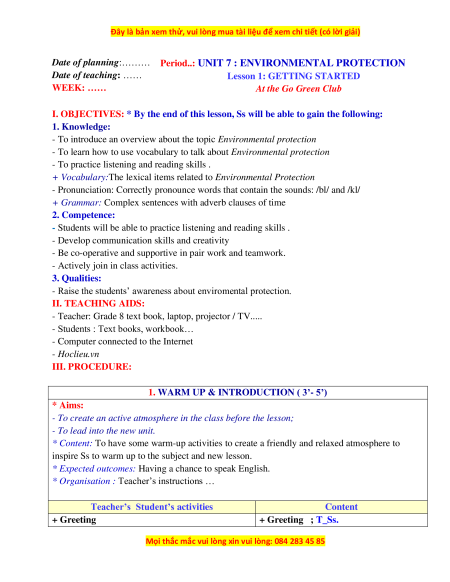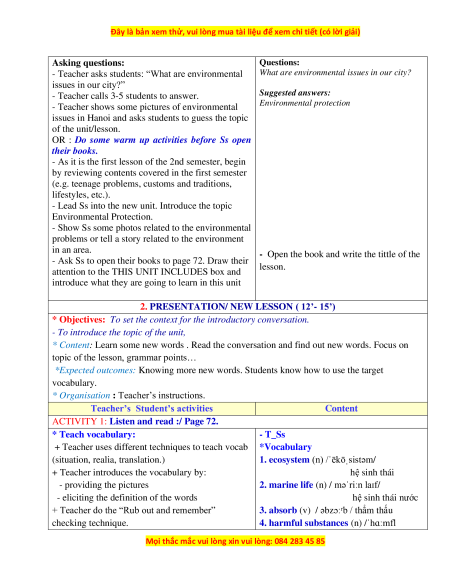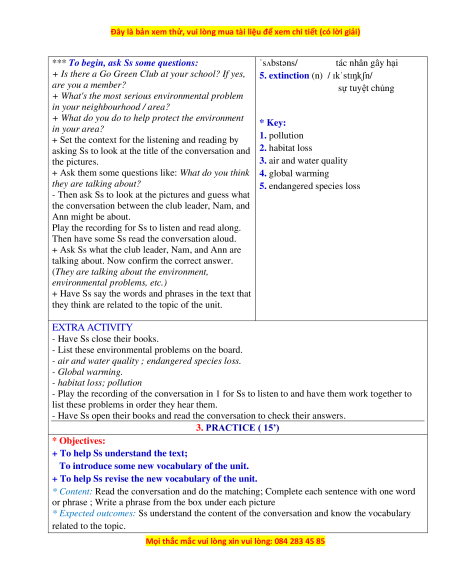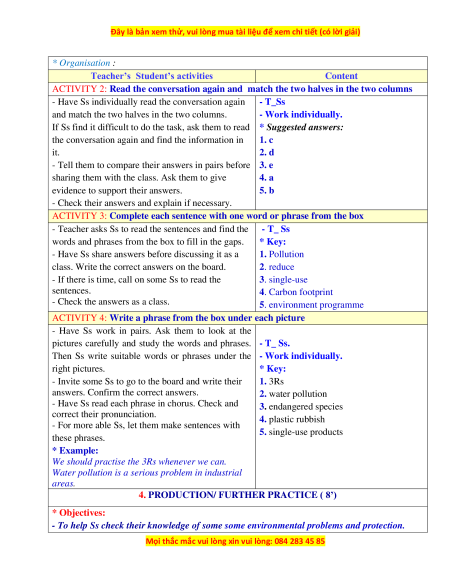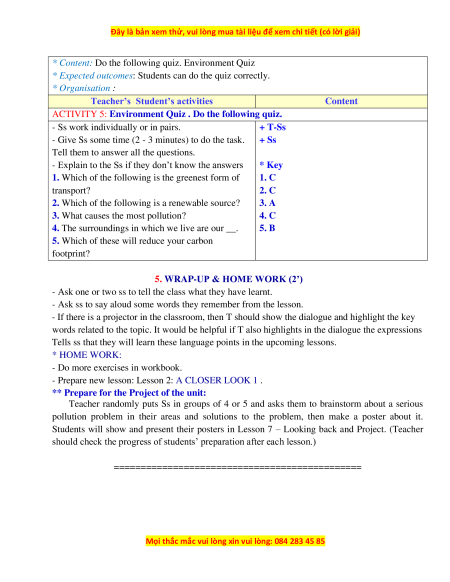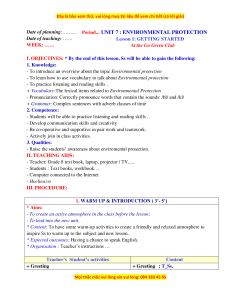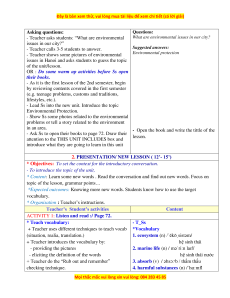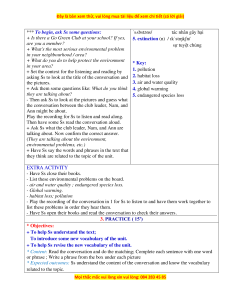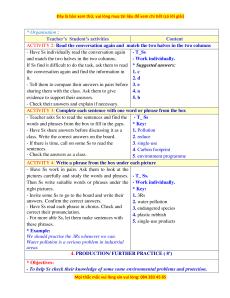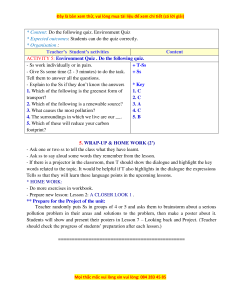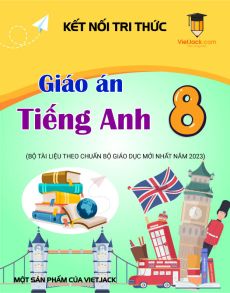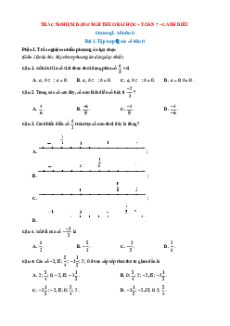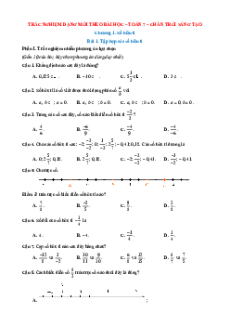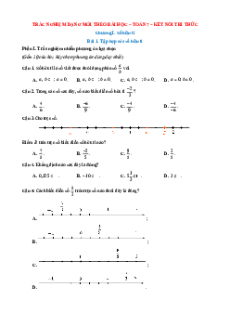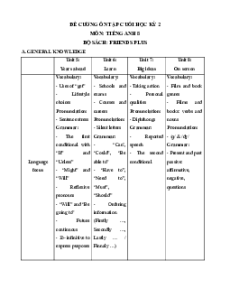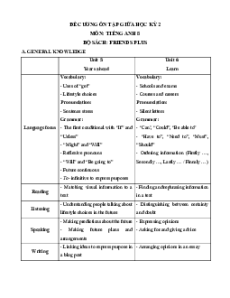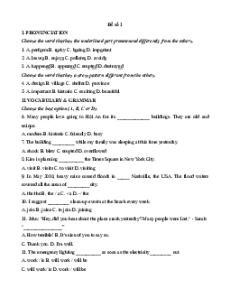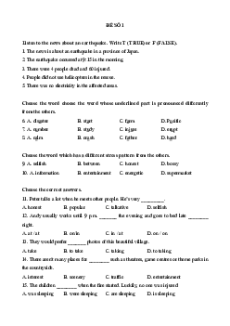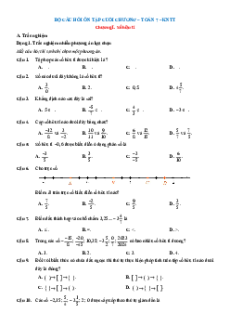Date of planning:……… Period..: UNIT 7 : ENVIRONMENTAL PROTECTION
Date of teaching: ……
Lesson 1: GETTING STARTED WEEK: ……
At the Go Green Club
I. OBJECTIVES: * By the end of this lesson, Ss will be able to gain the following: 1. Knowledge:
- To introduce an overview about the topic Environmental protection
- To learn how to use vocabulary to talk about Environmental protection
- To practice listening and reading skills .
+ Vocabulary:The lexical items related to Environmental Protection
- Pronunciation: Correctly pronounce words that contain the sounds: /bl/ and /kl/
+ Grammar: Complex sentences with adverb clauses of time 2. Competence:
- Students will be able to practice listening and reading skills .
- Develop communication skills and creativity
- Be co-operative and supportive in pair work and teamwork.
- Actively join in class activities. 3. Qualities:
- Raise the students’ awareness about enviromental protection. II. TEACHING AIDS:
- Teacher: Grade 8 text book, laptop, projector / TV.....
- Students : Text books, workbook…
- Computer connected to the Internet - Hoclieu.vn III. PROCEDURE:
1. WARM UP & INTRODUCTION ( 3’- 5’) * Aims:
- To create an active atmosphere in the class before the lesson; - To lead into the new unit.
* Content: To have some warm-up activities to create a friendly and relaxed atmosphere to
inspire Ss to warm up to the subject and new lesson.
* Expected outcomes: Having a chance to speak English.
* Organisation : Teacher’s instructions …
Teacher’s Student’s activities Content + Greeting + Greeting ; T_Ss.
Asking questions: Questions:
- Teacher asks students: “What are environmental
What are environmental issues in our city? issues in our city?”
- Teacher calls 3-5 students to answer.
Suggested answers:
- Teacher shows some pictures of environmental
Environmental protection
issues in Hanoi and asks students to guess the topic of the unit/lesson.
OR : Do some warm up activities before Ss open their books.
- As it is the first lesson of the 2nd semester, begin
by reviewing contents covered in the first semester
(e.g. teenage problems, customs and traditions, lifestyles, etc.).
- Lead Ss into the new unit. Introduce the topic Environmental Protection.
- Show Ss some photos related to the environmental
problems or tell a story related to the environment in an area.
- Open the book and write the tittle of the
- Ask Ss to open their books to page 72. Draw their lesson.
attention to the THIS UNIT INCLUDES box and
introduce what they are going to learn in this unit
2. PRESENTATION/ NEW LESSON ( 12’- 15’)
* Objectives: To set the context for the introductory conversation.
- To introduce the topic of the unit,
* Content: Learn some new words . Read the conversation and find out new words. Focus on
topic of the lesson, grammar points…
*Expected outcomes: Knowing more new words. Students know how to use the target vocabulary.
* Organisation : Teacher’s instructions.
Teacher’s Student’s activities Content
ACTIVITY 1: Listen and read :/ Page 72. * Teach vocabulary: - T_Ss
+ Teacher uses different techniques to teach vocab *Vocabulary
(situation, realia, translation.)
1. ecosystem (n) /ˈēkōˌsistəm/
+ Teacher introduces the vocabulary by: hệ sinh thái - providing the pictures
2. marine life (n) / məˈriːn laɪf/
- eliciting the definition of the words hệ sinh thái nước
+ Teacher do the “Rub out and remember”
3. absorb (v) / əbzɔːʳb / thẩm thấu checking technique.
4. harmful substances (n) /ˈhɑːmfl
*** To begin, ask Ss some questions:
ˈsʌbstəns/ tác nhân gây hại
+ Is there a Go Green Club at your school? If yes,
5. extinction (n) / ɪkˈstɪŋkʃn/ are you a member? sự tuyệt chủng
+ What's the most serious environmental problem
in your neighbourhood / area?
+ What do you do to help protect the environment * Key: in your area? 1. pollution
+ Set the context for the listening and reading by
asking Ss to look at the title of the conversation and 2. habitat loss the pictures.
3. air and water quality
+ Ask them some questions like: What do you think 4. global warming
they are talking about?
5. endangered species loss
- Then ask Ss to look at the pictures and guess what
the conversation between the club leader, Nam, and Ann might be about.
Play the recording for Ss to listen and read along.
Then have some Ss read the conversation aloud.
+ Ask Ss what the club leader, Nam, and Ann are
talking about. Now confirm the correct answer.
(They are talking about the environment, environmental problems, etc.)
+ Have Ss say the words and phrases in the text that
they think are related to the topic of the unit. EXTRA ACTIVITY - Have Ss close their books.
- List these environmental problems on the board.
- air and water quality ; endangered species loss. - Global warming. - habitat loss; pollution
- Play the recording of the conversation in 1 for Ss to listen to and have them work together to
list these problems in order they hear them.
- Have Ss open their books and read the conversation to check their answers. 3. PRACTICE ( 15’) * Objectives:
+ To help Ss understand the text;
To introduce some new vocabulary of the unit.
+ To help Ss revise the new vocabulary of the unit.
* Content: Read the conversation and do the matching; Complete each sentence with one word
or phrase ; Write a phrase from the box under each picture
* Expected outcomes: Ss understand the content of the conversation and know the vocabulary related to the topic.
* Organisation :
Teacher’s Student’s activities Content
ACTIVITY 2: Read the conversation again and match the two halves in the two columns
- Have Ss individually read the conversation again - T_Ss
and match the two halves in the two columns.
- Work individually.
If Ss find it difficult to do the task, ask them to read * Suggested answers:
the conversation again and find the information in 1. c it. 2. d
- Tell them to compare their answers in pairs before 3. e
sharing them with the class. Ask them to give 4. a
evidence to support their answers. 5. b
- Check their answers and explain if necessary.
ACTIVITY 3: Complete each sentence with one word or phrase from the box
- Teacher asks Ss to read the sentences and find the - T_ Ss
words and phrases from the box to fill in the gaps. * Key:
- Have Ss share answers before discussing it as a 1. Pollution
class. Write the correct answers on the board. 2. reduce
- If there is time, call on some Ss to read the 3. single-use sentences. 4. Carbon footprint
- Check the answers as a class.
5. environment programme
ACTIVITY 4: Write a phrase from the box under each picture
- Have Ss work in pairs. Ask them to look at the
pictures carefully and study the words and phrases. - T_ Ss.
Then Ss write suitable words or phrases under the - Work individually. right pictures. * Key:
- Invite some Ss to go to the board and write their 1. 3Rs
answers. Confirm the correct answers.
2. water pollution
- Have Ss read each phrase in chorus. Check and
3. endangered species correct their pronunciation.
4. plastic rubbish
- For more able Ss, let them make sentences with
5. single-use products these phrases. * Example:
We should practise the 3Rs whenever we can.
Water pollution is a serious problem in industrial areas.
4. PRODUCTION/ FURTHER PRACTICE ( 8’) * Objectives:
- To help Ss check their knowledge of some some environmental problems and protection.
Giáo án Unit 7: Environmental protection Tiếng Anh 8 Global success
769
385 lượt tải
MUA NGAY ĐỂ XEM TOÀN BỘ TÀI LIỆU
CÁCH MUA:
- B1: Gửi phí vào TK:
1133836868- CT TNHH DAU TU VA DV GD VIETJACK - Ngân hàng MB (QR) - B2: Nhắn tin tới Zalo VietJack Official ( nhấn vào đây ) để xác nhận thanh toán và tải tài liệu - giáo án
Liên hệ ngay Hotline hỗ trợ: 084 283 45 85
Bộ giáo án Tiếng Anh 8 Global success đã cập nhật đủ Cả năm.
Để tải tài liệu gốc về máy bạn click vào nút Tải Xuống ở trên!
Thuộc bộ (mua theo bộ để tiết kiệm hơn):
- Bộ giáo án Tiếng Anh 8 Global success năm 2024 Tặng kèm bộ tài liệu Đề kiểm tra theo từng unit, đề thi Giữa kì, học kì và bộ bài tập luyện chuyên sâu mới, chuẩn nhất được thiết kế theo phong cách hiện đại, đẹp mắt, trình bày chi tiết cho từng bài học và bám sát chương trình Sách giáo khoa Tiếng Anh 8 Kết nối tri thức.
- Mua trọn bộ sẽ tiết kiệm hơn tải lẻ 50%.
Đánh giá
4.6 / 5(769 )5
4
3
2
1
Trọng Bình
Tài liệu hay
Giúp ích cho tôi rất nhiều
Duy Trần
Tài liệu chuẩn
Rất thích tài liệu bên VJ soạn (bám sát chương trình dạy)
TÀI LIỆU BỘ BÁN CHẠY MÔN Toán Học
Xem thêmTÀI LIỆU BỘ BÁN CHẠY Lớp 8
Xem thêmTài liệu bộ mới nhất

Đây là bản xem thử, vui lòng mua tài liệu để xem chi tiết (có lời giải)
Mọi thắc mắc vui lòng xin vui lòng: 084 283 45 85
Date of planning:………
Date of teaching: ……
WEEK: ……
Period..: UNIT 7 : ENVIRONMENTAL PROTECTION
Lesson 1: GETTING STARTED
At the Go Green Club
I. OBJECTIVES: * By the end of this lesson, Ss will be able to gain the following:
1. Knowledge:
- To introduce an overview about the topic Environmental protection
- To learn how to use vocabulary to talk about Environmental protection
- To practice listening and reading skills .
+ Vocabulary:The lexical items related to Environmental Protection
- Pronunciation: Correctly pronounce words that contain the sounds: /bl/ and /kl/
+ Grammar: Complex sentences with adverb clauses of time
2. Competence:
- Students will be able to practice listening and reading skills .
- Develop communication skills and creativity
- Be co-operative and supportive in pair work and teamwork.
- Actively join in class activities.
3. Qualities:
- Raise the students’ awareness about enviromental protection.
II. TEACHING AIDS:
- Teacher: Grade 8 text book, laptop, projector / TV.....
- Students : Text books, workbook…
- Computer connected to the Internet
- Hoclieu.vn
III. PROCEDURE:
1. WARM UP & INTRODUCTION ( 3’- 5’)
* Aims:
- To create an active atmosphere in the class before the lesson;
- To lead into the new unit.
* Content: To have some warm-up activities to create a friendly and relaxed atmosphere to
inspire Ss to warm up to the subject and new lesson.
* Expected outcomes: Having a chance to speak English.
* Organisation : Teacher’s instructions …
Teacher’s Student’s activities
Content
+ Greeting
+ Greeting ; T_Ss.

Đây là bản xem thử, vui lòng mua tài liệu để xem chi tiết (có lời giải)
Mọi thắc mắc vui lòng xin vui lòng: 084 283 45 85
Asking questions:
- Teacher asks students: “What are environmental
issues in our city?”
- Teacher calls 3-5 students to answer.
- Teacher shows some pictures of environmental
issues in Hanoi and asks students to guess the topic
of the unit/lesson.
OR : Do some warm up activities before Ss open
their books.
- As it is the first lesson of the 2nd semester, begin
by reviewing contents covered in the first semester
(e.g. teenage problems, customs and traditions,
lifestyles, etc.).
- Lead Ss into the new unit. Introduce the topic
Environmental Protection.
- Show Ss some photos related to the environmental
problems or tell a story related to the environment
in an area.
- Ask Ss to open their books to page 72. Draw their
attention to the THIS UNIT INCLUDES box and
introduce what they are going to learn in this unit
Questions:
What are environmental issues in our city?
Suggested answers:
Environmental protection
- Open the book and write the tittle of the
lesson.
2. PRESENTATION/ NEW LESSON ( 12’- 15’)
* Objectives: To set the context for the introductory conversation.
- To introduce the topic of the unit,
* Content: Learn some new words . Read the conversation and find out new words. Focus on
topic of the lesson, grammar points…
*Expected outcomes: Knowing more new words. Students know how to use the target
vocabulary.
* Organisation : Teacher’s instructions.
Teacher’s Student’s activities
Content
ACTIVITY 1: Listen and read :/ Page 72.
* Teach vocabulary:
+ Teacher uses different techniques to teach vocab
(situation, realia, translation.)
+ Teacher introduces the vocabulary by:
- providing the pictures
- eliciting the definition of the words
+ Teacher do the “Rub out and remember”
checking technique.
- T_Ss
*Vocabulary
1. ecosystem (n) /ˈēkōˌsistəm/
hệ sinh thái
2. marine life (n) / məˈriːn laɪf/
hệ sinh thái nước
3. absorb (v) / əbzɔːʳb / thẩm thấu
4. harmful substances (n) /ˈhɑːmfl

Đây là bản xem thử, vui lòng mua tài liệu để xem chi tiết (có lời giải)
Mọi thắc mắc vui lòng xin vui lòng: 084 283 45 85
*** To begin, ask Ss some questions:
+ Is there a Go Green Club at your school? If yes,
are you a member?
+ What's the most serious environmental problem
in your neighbourhood / area?
+ What do you do to help protect the environment
in your area?
+ Set the context for the listening and reading by
asking Ss to look at the title of the conversation and
the pictures.
+ Ask them some questions like: What do you think
they are talking about?
- Then ask Ss to look at the pictures and guess what
the conversation between the club leader, Nam, and
Ann might be about.
Play the recording for Ss to listen and read along.
Then have some Ss read the conversation aloud.
+ Ask Ss what the club leader, Nam, and Ann are
talking about. Now confirm the correct answer.
(They are talking about the environment,
environmental problems, etc.)
+ Have Ss say the words and phrases in the text that
they think are related to the topic of the unit.
ˈsʌbstəns/ tác nhân gây hại
5. extinction (n) / ɪkˈstɪŋkʃn/
sự tuyệt chủng
* Key:
1. pollution
2. habitat loss
3. air and water quality
4. global warming
5. endangered species loss
EXTRA ACTIVITY
- Have Ss close their books.
- List these environmental problems on the board.
- air and water quality ; endangered species loss.
- Global warming.
- habitat loss; pollution
- Play the recording of the conversation in 1 for Ss to listen to and have them work together to
list these problems in order they hear them.
- Have Ss open their books and read the conversation to check their answers.
3. PRACTICE ( 15’)
* Objectives:
+ To help Ss understand the text;
To introduce some new vocabulary of the unit.
+ To help Ss revise the new vocabulary of the unit.
* Content: Read the conversation and do the matching; Complete each sentence with one word
or phrase ; Write a phrase from the box under each picture
* Expected outcomes: Ss understand the content of the conversation and know the vocabulary
related to the topic.

Đây là bản xem thử, vui lòng mua tài liệu để xem chi tiết (có lời giải)
Mọi thắc mắc vui lòng xin vui lòng: 084 283 45 85
* Organisation :
Teacher’s Student’s activities
Content
ACTIVITY 2: Read the conversation again and match the two halves in the two columns
- Have Ss individually read the conversation again
and match the two halves in the two columns.
If Ss find it difficult to do the task, ask them to read
the conversation again and find the information in
it.
- Tell them to compare their answers in pairs before
sharing them with the class. Ask them to give
evidence to support their answers.
- Check their answers and explain if necessary.
- T_Ss
- Work individually.
* Suggested answers:
1. c
2. d
3. e
4. a
5. b
ACTIVITY 3: Complete each sentence with one word or phrase from the box
- Teacher asks Ss to read the sentences and find the
words and phrases from the box to fill in the gaps.
- Have Ss share answers before discussing it as a
class. Write the correct answers on the board.
- If there is time, call on some Ss to read the
sentences.
- Check the answers as a class.
- T_ Ss
* Key:
1. Pollution
2. reduce
3. single-use
4. Carbon footprint
5. environment programme
ACTIVITY 4: Write a phrase from the box under each picture
- Have Ss work in pairs. Ask them to look at the
pictures carefully and study the words and phrases.
Then Ss write suitable words or phrases under the
right pictures.
- Invite some Ss to go to the board and write their
answers. Confirm the correct answers.
- Have Ss read each phrase in chorus. Check and
correct their pronunciation.
- For more able Ss, let them make sentences with
these phrases.
* Example:
We should practise the 3Rs whenever we can.
Water pollution is a serious problem in industrial
areas.
- T_ Ss.
- Work individually.
* Key:
1. 3Rs
2. water pollution
3. endangered species
4. plastic rubbish
5. single-use products
4. PRODUCTION/ FURTHER PRACTICE ( 8’)
* Objectives:
- To help Ss check their knowledge of some some environmental problems and protection.

Đây là bản xem thử, vui lòng mua tài liệu để xem chi tiết (có lời giải)
Mọi thắc mắc vui lòng xin vui lòng: 084 283 45 85
* Content: Do the following quiz. Environment Quiz
* Expected outcomes: Students can do the quiz correctly.
* Organisation :
Teacher’s Student’s activities
Content
ACTIVITY 5: Environment Quiz . Do the following quiz.
- Ss work individually or in pairs.
- Give Ss some time (2 - 3 minutes) to do the task.
Tell them to answer all the questions.
- Explain to the Ss if they don’t know the answers
1. Which of the following is the greenest form of
transport?
2. Which of the following is a renewable source?
3. What causes the most pollution?
4. The surroundings in which we live are our __.
5. Which of these will reduce your carbon
footprint?
+ T-Ss
+ Ss
* Key
1. C
2. C
3. A
4. C
5. B
5. WRAP-UP & HOME WORK (2’)
- Ask one or two ss to tell the class what they have learnt.
- Ask ss to say aloud some words they remember from the lesson.
- If there is a projector in the classroom, then T should show the dialogue and highlight the key
words related to the topic. It would be helpful if T also highlights in the dialogue the expressions
Tells ss that they will learn these language points in the upcoming lessons.
* HOME WORK:
- Do more exercises in workbook.
- Prepare new lesson: Lesson 2: A CLOSER LOOK 1 .
** Prepare for the Project of the unit:
Teacher randomly puts Ss in groups of 4 or 5 and asks them to brainstorm about a serious
pollution problem in their areas and solutions to the problem, then make a poster about it.
Students will show and present their posters in Lesson 7 – Looking back and Project. (Teacher
should check the progress of students’ preparation after each lesson.)
==============================================
